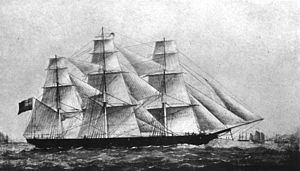Name Lord of the Isles Depth of hold 18.5 ft (5.6 m) | Beam 27.8 ft (8.5 m) Launched 1853 | |
 | ||
Tonnage 770 tons OM691 tons NM Length 210 ft (64 m) Length overall185 ft (56 m) Length of keel | ||
The Lord of the Isles was the first iron-hulled tea clipper, built in Greenock in 1853. She served in the tea trade until 1862, and also made voyages to Australia. She is known for a record passage between Greenock and Shanghai, and for her close finish in the 1856 Tea Race from China to England, docking in London just ten minutes before the Maury. This race was the basis for the plot of a 1927 movie by Cecil B. DeMille The Yankee Clipper.
Contents
Construction
The construction of Lord of the Isles was considered to be ahead of her time. Her hull was built entirely of iron. She had a higher proportion of beam to length for the vessels of that decade, with a ratio of 6:4. Her ends were so fine that she earned the nickname "The Diving Bell", as her well-known skipper Capt. Peter Maxton said she would dive into one side of a sea and out at the other.
Voyages
Lord of the Isles' maiden voyage, from Greenock to Sydney, Australia was 70 days. In 1858, she returned to Greenock from Shanghai in a record time of 89 days. She made three voyages to Australia, but her principal route was the tea trade between London and the Chinese cities of Whampoa and Shanghai.
Race with the Maury in 1856
In 1856, the Lord of the Isles raced the American clipper bark Maury, for a price of a one-pound-per-ton premium to be awarded to the first ship to reach London bearing the year’s new crop of tea. Lord of the Isles finished loading first, and set sail four days ahead of the Maury. After a 127-day voyage and thirteen thousand miles of ocean sailing, the two ships passed Gravesend “within ten minutes of each other.” Having a better tugboat at her disposal, the Lord of the Isles docked as the first tea ship of the season, winning the honors.
Lord of the Isles was known for delivering her cargoes undamaged. Despite her success, iron ships did not become popular in the tea trade, and there were no further iron tea clippers built until the 1870s.
Loss of the ship
On July 24, 1862, Lord of the Isles caught fire at 114 or 115°50'E 12°13'N en route to Hong Kong from Greenock. The cause was thought to be spontaneous combustion of bales of felt placed next to her cargo of railroad iron. Captain Davies, the crew and passengers, thirty people in all, made Macao in the ship’s boats, despite being boarded twice by pirates.
In movies
The Yankee Clipper, a 1927 adventure movie produced by Cecil D. DeMille, features a race between the Lord of the Isles against the American ship Yankee Clipper for rights to the Foochow tea trade. The film was shot aboard a surviving 1850s square-rigger, the Indiana, and includes footage taken from high in the rigging under sail.
